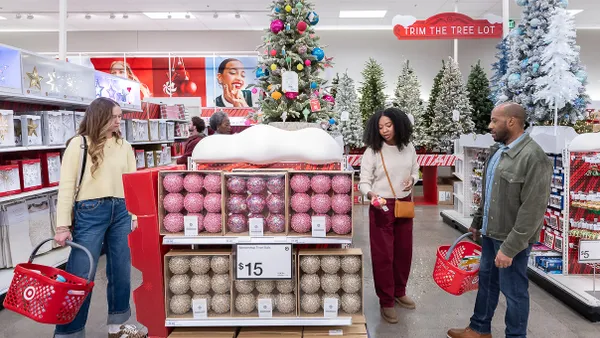Dive Brief:
-
Consumers plan to spend 3.4% more at the holidays this year, an average of $967.13 compared to $935.58 last year, according to the annual survey conducted by Prosper Insights & Analytics for the National Retail Federation. Retailers are bracing themselves for a strong holiday season by ramping up import activity, setting an all-time high late this summer and continuing unusually high import volume this fall, according to NRF's monthly Global Port Tracker report.
-
That's a bit more optimistic than research from brand loyalty consultancy Brand Keys, which found consumers signaling a 4% increase in their holiday spend this year to an average of $936 per household, according to a report emailed to Retail Dive.
-
The NRF, Brand Keys and global information company the NPD Group all found that holiday shopping is trending toward an early start. The NPD Group found that this year will be the first time that more U.S. consumers start shopping in the middle of the season (Thanksgiving weekend through Cyber Monday) than will start late (early December). The holiday shopping season is also expected to be longer, spreading over a four month-plus period and no longer relegated to the 61 days of November and December, according to Brand Keys.
Dive Insight:
The holidays are advancing with a favorable economic backdrop. Advanced third quarter GDP increased 3% from the second quarter, which itself was up 3.1% from Q1, noted Retail Metrics President Ken Perkins in an email to Retail Dive, adding that weekly initial jobless claims touched a 44-year low mid-month, unemployment and job gains are in solid condition, and the housing market remains strong, held back by lack of inventory.
For the NRF, Prosper found that just 27% of consumers say their spending will be impacted by concerns about the nation's economy, down from 32% during 2016's election-year jitters and the lowest level since NRF began asking the question during the Great Recession of 2009.
"With employment and incomes increasing, consumers are more confident this year and that is reflected in their buying plans for the holidays," NRF President and CEO Matthew Shay said in a statement. "Retailers have been stocking up in expectation of this, and all signs are that this will be a busy holiday season. Retailers are preparing for a rush of consumers leading into Thanksgiving and all through December, and are offering a wide array of merchandise and promotions so shoppers can find great gifts and great deals at the same time."
Still, retail is facing a host of other challenges, Perkins noted. "The elements for consumer spending growth are in place and yet retailers are fighting for their lives as the industry transforms and consolidates," he said. That makes it imperative that retailers leave little to chance during their all-important fourth quarter, including taking note of a clear shift in spending patterns.
"The consumer that used to wait until after Thanksgiving weekend now shops during it," Marshal Cohen, chief industry analyst at the NPD Group, said in a statement emailed to Retail Dive. "Despite all the efforts in recent years to get shoppers shopping before Black Friday week, we see little to no movement early in the season, but the last-minute shoppers have moved their timing up."
But Brand Keys and the NRF found that consumers are indeed making decisions and plan to shop even earlier. Most (59%) are waiting until at least November to begin holiday shopping, but 22% started or were planning to start in October and 19% in September or earlier, according to the NRF. "Retailers have recognized shifts in the consumer shopping paradigm, and will again try to capitalize on them by kicking off Black Friday-like sales even earlier than in previous years," Robert Passikoff, founder and president of Brand Keys, told Retail Dive in an email. "This is an incredibly important shift."
While many consumers are holding off until November or later to start their holiday shopping, retailers should be prepared for high traffic online and in stores come Thanksgiving weekend as customers start tackling their lists, according to Prosper Insights Principal Analyst Pam Goodfellow. "Although sales will remain an important factor for most consumers, many will lean on convenient locations and easy-to-use websites or mobile apps along with free shipping to complete their purchases," she said.
Of the early shoppers, 65% told Prosper that they are trying to spread out their budgets while 49% do not want the stress of last-minute shopping and 48% want to avoid the crowds.
It means that a 'season' that represents nearly 25% of the retail industry's total sales is spread out — conservatively speaking — over a four month-plus period, even though the 'Winter Holidays' have traditionally been defined as the 61 days of November and December, Passikoff said, adding, "It may work that way on the calendar, but not in successful retailers' marketing strategies!"
Holiday spending comes in three main categories, according to the NRF: gifts ($608.06); items such as food, decorations, flowers and greeting cards ($218.08); and other non-gift items consumers buy for themselves and their families ($140.99). For the first time in the NRF survey's history, more of that spending will be online than in stores. Or at least more than half (59%) of consumers say they'll shop online, while 57% will shop at a department store, 54% at a discount store, 46% at a grocery store or supermarket and 35% at clothing or accessories stores. The survey also found 27% planning to visit an electronics store, 25% a small or local business and 18% a crafts or fabrics store.
Brand Keys also found that even more — virtually all consumers interviewed (98%) — are buying online this year. "It's no secret that brick-and-mortar retailers have had more difficult times engaging customers over the past five years," said Passikoff. "They've been trying to forestall the online assault with 'better' reward programs and low-lower-lowest pricing schemes, but consumers are on to that. Online has become the default venue for browsing, promotions, price checking and, ultimately, buying holiday gifts."
Brand Keys found other popular holiday shopping venues to be discount department stores (95%), specialty and apparel (75%), traditional department stores (73%), electronics stores (25%), price clubs (24%), sporting goods stores (18%) and outlet stores (15%)
Catalogues (8%), are down again, another 2% from last year — something Passikoff attributes to the rising importance of online research. "If a consumer can pull up the same content on a computer, a tablet or a smartphone, they regard hard-copy as redundant," he said. Still, in many instances, paper catalogs still matter.
For the eleventh year in a row, Prosper found gift cards to be the most popular items, requested by 61%, followed by clothing and accessories (55%, the highest level in 12 years). On the other hand, only two in five (39%) would like books, music or movies, the lowest in survey history; others asked for consumer electronics (33%), home décor (24%), jewelry (23%), personal care or beauty items (21%), sporting goods (20%) and home improvement items (18%), according to NRF and Prosper.
Most online shoppers will take advantage of free shipping (94%) and conveniences like buy online, pick up in store (49%); 19% will take advantage of expedited shipping and 12% will use same-day delivery, the NRF also found.
The NPD Group conducted an online survey in September 2017 among a U.S. representative sample of NPD online consumer panel members. The survey was completed by 3,785 individuals aged 18 and older. Brand Keys surveyed 11,625 shoppers and Prosper surveyed 7,349 consumers Oct. 3-10 for the NRF.
This story is part of our ongoing coverage of the 2017 holiday shopping season. You can browse our holiday page and sign up for our holiday newsletter for more stories.












